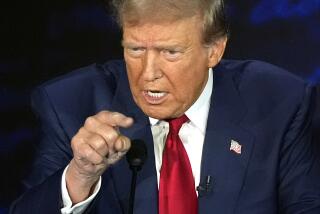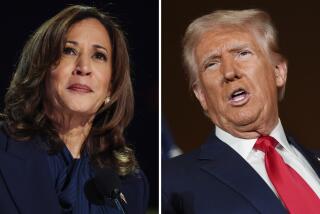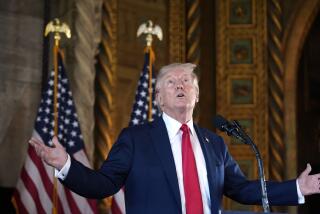Trump’s North Korea summit comes together, even as relations with U.S. allies fall apart
President Trump’s ardently sought summit with Kim Jong Un of North Korea seems on again; so does his growing trade war with America’s closest allies.
Before Trump, either of those events would have seemed wildly unlikely. For them to unfold simultaneously this week underscored the head-spinning nature of Trump’s presidency.
And that was even before Trump got around to pardons.
Sign up for the Essential Politics newsletter »
CALIFORNIA VOTES
Tuesday brings the California primary and the answers to questions that have obsessed the political world for weeks: Will the state’s top-two primary system end up shutting out either party from key races? Will California ease Democrats’ path to a House majority or complicate it? Will anyone seriously challenge the favorites for governor and senator, Gavin Newsom and Dianne Feinstein? Our special page for the primary is the place to go for the most thorough and up-to-the-minute answers to those and other questions about California politics. Don’t miss it.
A NUCLEAR GAMBLE
A week ago, Trump abruptly called off the summit in Singapore, releasing a letter that said he was acting in response to the “tremendous anger and open hostility” in recent North Korean statements.
That set off a whirlwind of diplomacy aimed at putting the summit back together, starting Saturday with a surprise meeting between Kim and South Korean President Moon Jae-In.
As Matt Stiles and Noah Bierman wrote, the almost casual way in which the two Korean leaders quickly met to advance a common goal underscored the enormous change taking place on the Korean peninsula: Until this year, the leaders of North and South Korea had met only twice in more than six decades. Now, they’ve met twice in a month.
Trump, meanwhile, spent the Memorial Day weekend firing off angry tweets about the investigation into Russian efforts to influence the 2016 election, as Bierman wrote.
In one tweet, he denounced the New York Times for quoting an unnamed administration official as saying that putting the summit back on track would be logistically almost impossible given the short time left. The official didn’t exist, Trump said. In fact, the official not only existed, he had made the statement in a White House briefing attended by dozens of reporters who didn’t quote him by name because of White House ground rules.
By Tuesday, one of Kim’s closest aides, Gen. Kim Yong Chol, formerly North Korea’s espionage chief, was headed for New York, while teams of U.S. diplomats met with North Korean officials both in Korea and in Singapore. As Eli Stokols and Tracy Wilkinson wrote, plans for the summit were coming together rapidly, even as its substantive goals remained unclear.
On Wednesday, Secretary of State Mike Pompeo headed for New York, where he began talks with Gen. Kim over a dinner of filet mignon.
As Barbara Demick wrote, the meeting highlighted the mismatch in experience between the U.S. and North Korea: Pompeo has been in his job for barely a month and has never before handled nuclear negotiations. The North Korean spy chief has been involved in every nuclear negotiation his country has participated in since 1992.
He’s been involved in a lot else too: The U.S. has levied sanctions against him, personally, for his role in overseeing cyberattacks on American targets and physical attacks on South Korea.
By Thursday, the general was headed for Washington to hand-deliver a letter to Trump from Kim Jong Un. And the president appeared to be eager for a summit even if it didn’t produce an immediate agreement for North Korea to give up its nuclear arsenal, which he previously had insisted on.
“It doesn’t mean it gets all done at one meeting. Maybe you have to have a second or a third,” Trump told reporters.
Barring another sudden change of heart by Trump, the summit is on. The president and the North Korean leader are on track to meet in less than two weeks, and the most predicable outcome is that when the meeting ends, Trump will declare it a historic accomplishment.
It’s possible that his boast will prove true. Trump has broken all the rules of how the U.S. is supposed to negotiate with North Korea, but following those rules hasn’t gotten previous administrations very far. In a couple of weeks, Americans will get a chance to judge whether his audacious approach has broken a stalemate or just strengthened North Korea’s hand.
ANGERING THE ALLIES
While talks with North Korea were rapidly coming together, trade relations with America’s allies were falling apart.
In early March, when Trump first revealed that he planned to impose a 25% tax on imported steel and 10% on imports of aluminum — prompting his chief economic advisor, Gary Cohn, to quit — administration officials portrayed the move as part of a strategy of more aggressively confronting China.
But within days, Trump began making statements suggesting that he saw the metal tariffs as a bargaining chip to use in other negotiations. U.S. allies would be exempt for now, he said, but they would remain so only if they agreed to other trade demands.
That threat managed to toughen the bargaining positions of the European Union, Canada and Mexico. And on Thursday, administration officials announced that the tariffs would be imposed on those trading partners, starting Friday.
As Don Lee and Kate Linthicum wrote, the tariffs brought immediate retaliation against U.S. exports.
Canadian officials seemed particularly angered, especially by Trump’s justification of the tariffs on grounds of national security.
“That Canada could be a national security threat to the U.S. is inconceivable,” said Canadian Prime Minister Justin Trudeau, noting the Canadians who have died alongside U.S. soldiers in conflicts dating back to World War I.
With the U.S. having imposed tariffs, and Europe, Canada and Mexico having retaliated in kind, the question now is whether either side escalates further, economists said.
A trade conflict centered on steel and aluminum will raise prices for some U.S. goods but do limited damage. Consumers probably won’t feel much impact in the short run, analysts said.
But a spiral of escalating tariffs that go beyond the current ones could spin the world economy into a recession, economic forecasters warned.
Commerce Secretary Wilbur Ross sought to calm markets Thursday. He now heads to Beijing for a weekend of talks with Chinese officials. As Lee wrote, administration officials a week ago said the trade war with China was “on hold,” but this week appeared keen on reviving the conflict.
GLOBAL WARMING — ONE YEAR LATER
June 1 marks the anniversary of Trump’s announcement that he was pulling the U.S. out of the Paris agreement on fighting global warming.
As Evan Halper reports, one year later, environmental activists are still trying to contain the damage to international climate efforts.
Trump hasn’t been able to bring about a revival of the coal industry or turn around the long-term trend toward lower-emission vehicles. But “he has set in motion initiatives that will cause damage,” Gov. Jerry Brown said in an interview.
One of the administration’s initiatives involves allowing trucks with old, reconditioned engines onto the nation’s highways. California regulators say that move would greatly increase pollution.
The EPA argues that the trucks, known as gliders, would not pollute much more than existing trucks, but as Halper reported, that argument was based, in part, on privately financed research that now has been disavowed by the university where the study was conducted.
PARDON ME
Trump’s personality rebels against the Constitution’s elaborate system of checks and balances. That’s one reason presidential clemency power appeals to him — it’s about as close to unreviewable authority as a president gets.
Trump has acted five times to grant a pardon — including Thursday’s promise of clemency for Dinesh D’Souza, the conservative provocateur. As Jackie Calmes reported, only one of those pardons was reviewed by the Justice Department’s pardon attorney — an office set up in 1865 to provide an institutional check on the president’s clemency power.
Trump’s pardon of D’Souza, and his suggestions that he might pardon Martha Stewart and reduce the sentence for Rod Blagojevich, the former Illinois governor, fit a couple of patterns, Calmes wrote: Trump has used his power to benefit political allies, and he’s been attracted to cases prosecuted by his nemeses.
D’Souza was prosecuted by Preet Bharara, whom Trump fired as U.S. attorney in Manhattan. Stewart’s prosecution was directed by one of Bharara’s predecessors in that job, James B. Comey, whom Trump later fired from his job as FBI director.
Blagojevich’s prosecutor was Patrick Fitzgerald, a friend of Comey’s who also prosecuted another recipient of a Trump pardon, I. Lewis “Scooter” Libby, a former top aide to Vice President Dick Cheney.
The pardons also sent an unmistakable signal to people caught up in the Russia investigation: The president can, if he chooses, keep you out of prison.
STILL FURIOUS AT SESSIONS
For a year now, Trump has wanted to fire Atty. Gen. Jeff Sessions but has bowed to his staff and GOP Senate leaders, who have warned him that he might not be able to get anyone else confirmed for the job.
Periodically, however, Trump’s deep anger at his attorney general has flared. As Bierman wrote, it did so again this week, as Trump tweeted that he wished he had picked someone else for the job.
Trump regards Sessions’ decision to recuse himself from the Russia investigation as a betrayal, and he blames the recusal for the appointment of the special counsel, Robert S. Mueller III, and all that his investigators have done.
The latest outbursts about Sessions came as Trump has tried to push the theory that the FBI improperly spied on his campaign early in its investigation of Russian interference in the election.
What Trump has dubbed “Spygate” has gotten considerable traction among his supporters. But, as Chris Megerian wrote, this week, some prominent Republicans distanced themselves from Trump’s conspiracy theory.
EXPANDING MEDICAID
The Affordable Care Act had two main avenues to expand healthcare coverage. One was a private-sector mechanism — the marketplaces in which people who didn’t get coverage at work could buy insurance and receive government subsidies to help pay for it. The other was a government program, an expansion of Medicaid to cover low-income, working adults.
Of the two, the government program has proved by far the more effective — a lesson that has shaped Democratic thinking about what to push for the next time they come to power.
Even as Republicans have tried to undermine the marketplaces, more states have chosen to expand Medicaid. This week saw a major step as Virginia became the 33rd state to expand Medicaid under the law, as Noam Levey wrote.
Virginia’s action was a major victory for the Gov. Ralph Northam and a tangible result of Democratic victories in last fall’s legislative elections in the state.
MCCARTHY STILL STRUGGLING
Weeks after House Speaker Paul D. Ryan announced that he would not run for reelection, Rep. Kevin McCarthy, Ryan’s putative heir, is still having a hard time locking down the speaker’s job, Sarah Wire reported. McCarthy (R-Bakersfield) faces continued resistance from conservatives in the Republican caucus.
LOGISTICS
That wraps up this week. My colleague Christina Bellantoni will be back Monday with the weekday edition of Essential Politics. Until then, keep track of all the developments in national politics and the Trump administration with our Essential Washington blog, at our Politics page and on Twitter @latimespolitics.
Send your comments, suggestions and news tips to politics@latimes.com.
If you like this newsletter, tell your friends to sign up.
More to Read
Get the L.A. Times Politics newsletter
Deeply reported insights into legislation, politics and policy from Sacramento, Washington and beyond. In your inbox three times per week.
You may occasionally receive promotional content from the Los Angeles Times.











